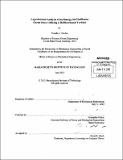Experimental analysis of an energy self sufficient ocean buoy utilizing a bi-directional turbine
Author(s)
Gruber, Timothy J. (Timothy James)
DownloadFull printable version (9.516Mb)
Other Contributors
Massachusetts Institute of Technology. Dept. of Mechanical Engineering.
Advisor
Alexandra Techet.
Terms of use
Metadata
Show full item recordAbstract
An experimental analysis of a Venturi shrouded hydro turbine for wave energy conversion. The turbine is designed to meet the specific power requirements of a, Woods Hole Oceanographic Institute offshore monitoring buoy using a unique gumby hose mooring system. The buoy's mission is to monitor the Massachusetts Bay for Right whale vocalizations. The turbine needed to convert a suitable amount of energy without interfering with the buoy's overall survivability or mission readiness. The turbine was a Babinsten impulse bi-directional turbine which used sea water as the working fluid. Testing was conducted in a recirculating water tunnel, and two flow visualization techniques were applied. This was the first project in the MIT water tunnel since a major renovation and upgrade., and thus included a large amount of equipment set up and performance analysis. The turbine utilized a Venturi shaped shroud, with a maximum diameter of 25.4 cm contracting down to 10.0 cm diameter where the blades were located. Ultimately PIV images revealed that the Venturi shroud was creating a large stagnation region at, the turbine inlet. This stagnation region choked off flow through the turbine, resulting in poor power production. Subsequent testing revealed that the shroud without the turbine blades also produced a large stagnation region. casting doubt on the concept of Venturi shrouded turbines in general. The device failed to meet the requirements for the WHOI buoy and was not a suitable solution for converting the buoy to energy self sufficiency.
Description
Thesis (S.M.)--Massachusetts Institute of Technology, Dept. of Mechanical Engineering, 2012. Cataloged from PDF version of thesis. Includes bibliographical references (p. 73-75).
Date issued
2012Department
Massachusetts Institute of Technology. Department of Mechanical EngineeringPublisher
Massachusetts Institute of Technology
Keywords
Mechanical Engineering.